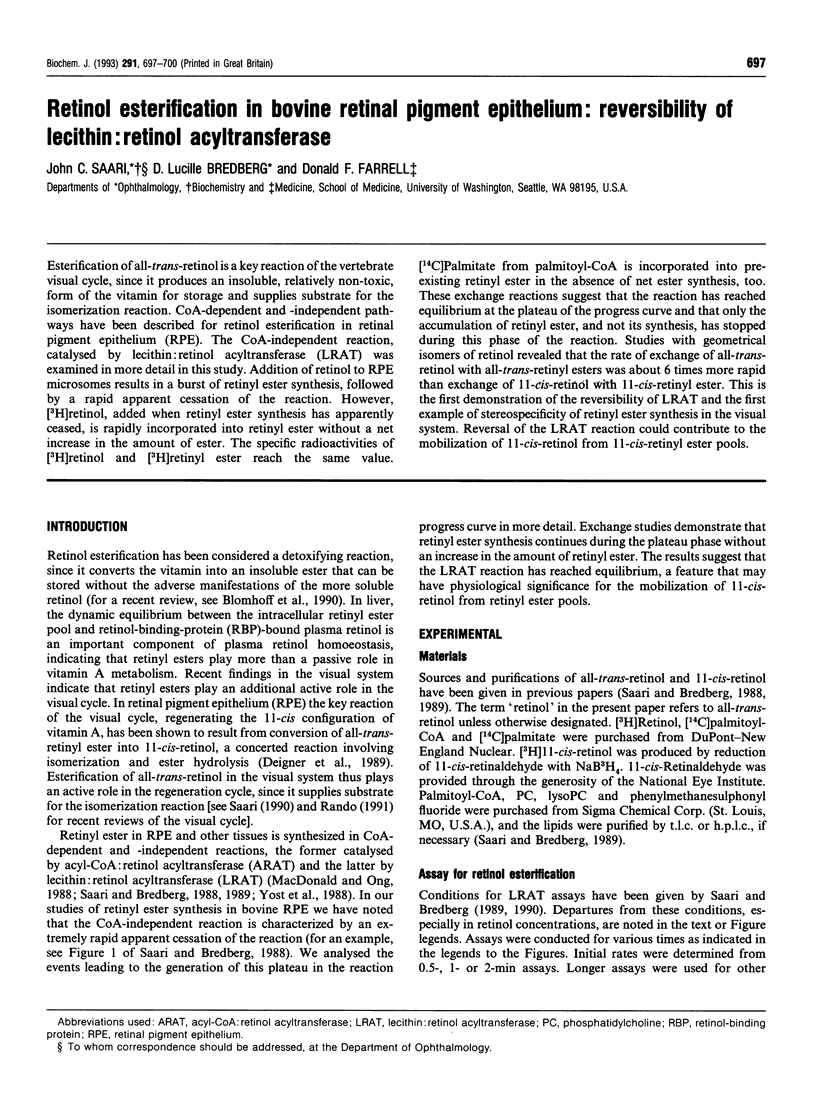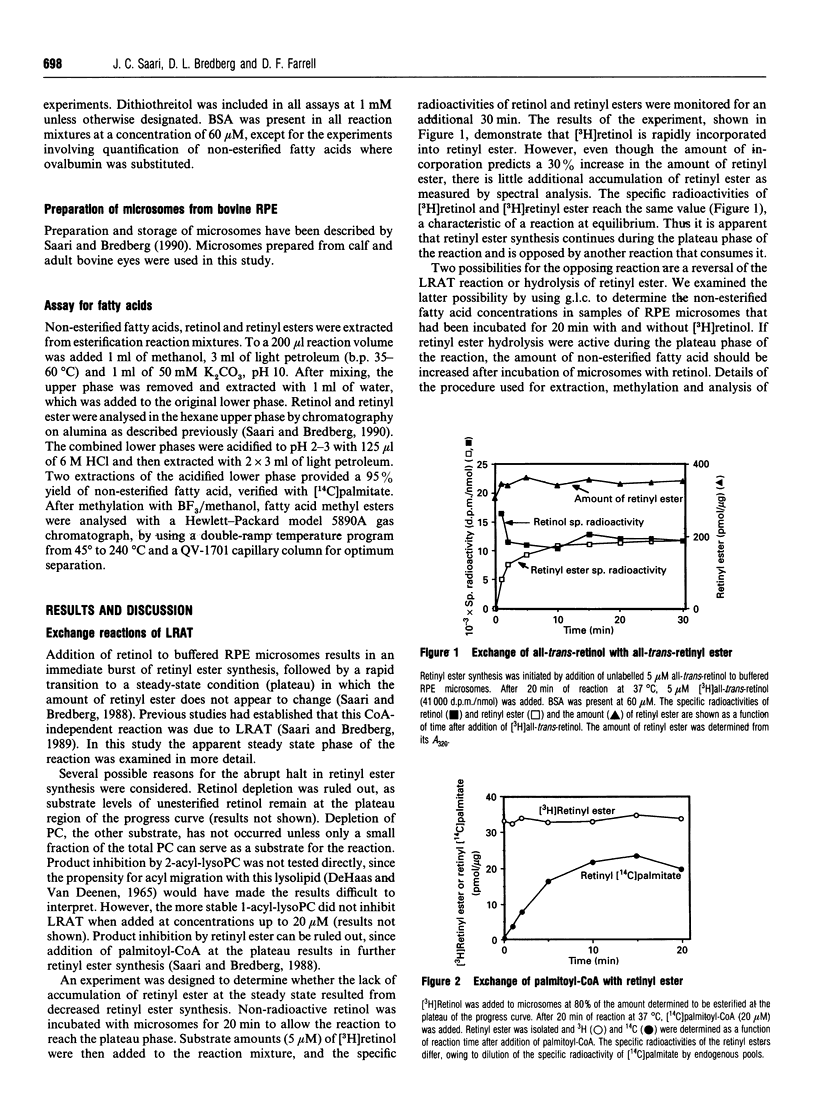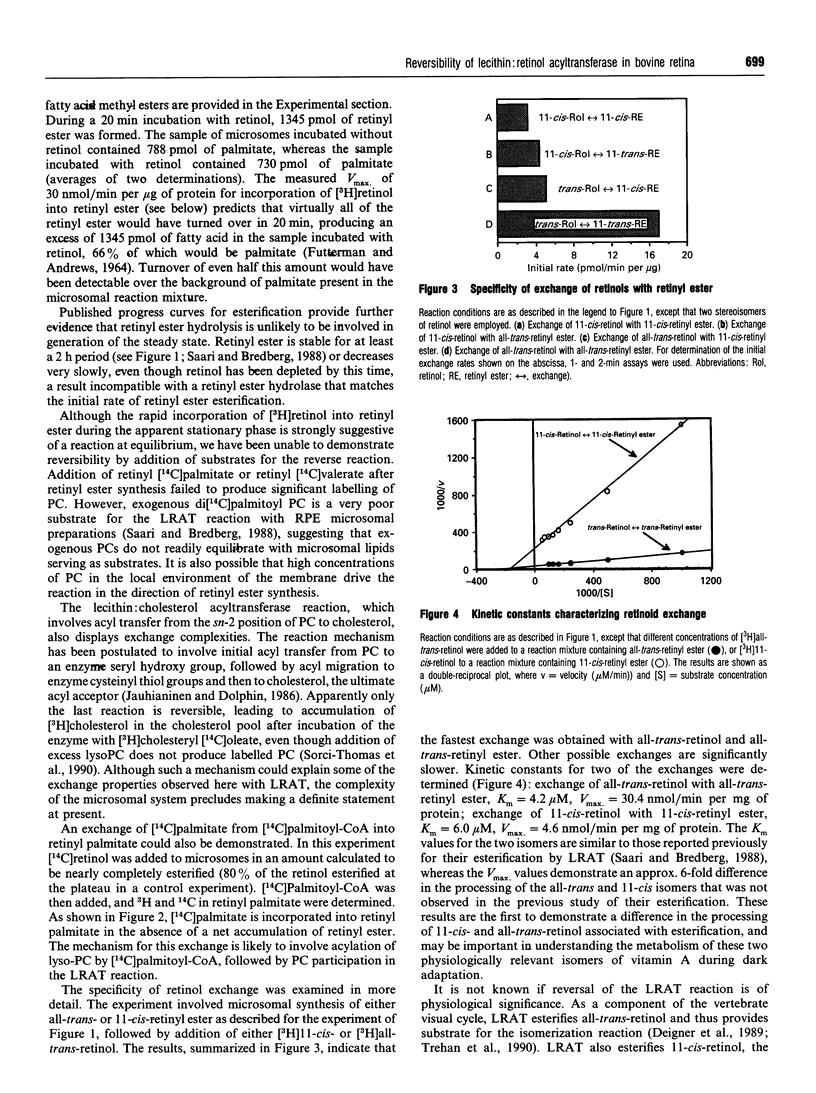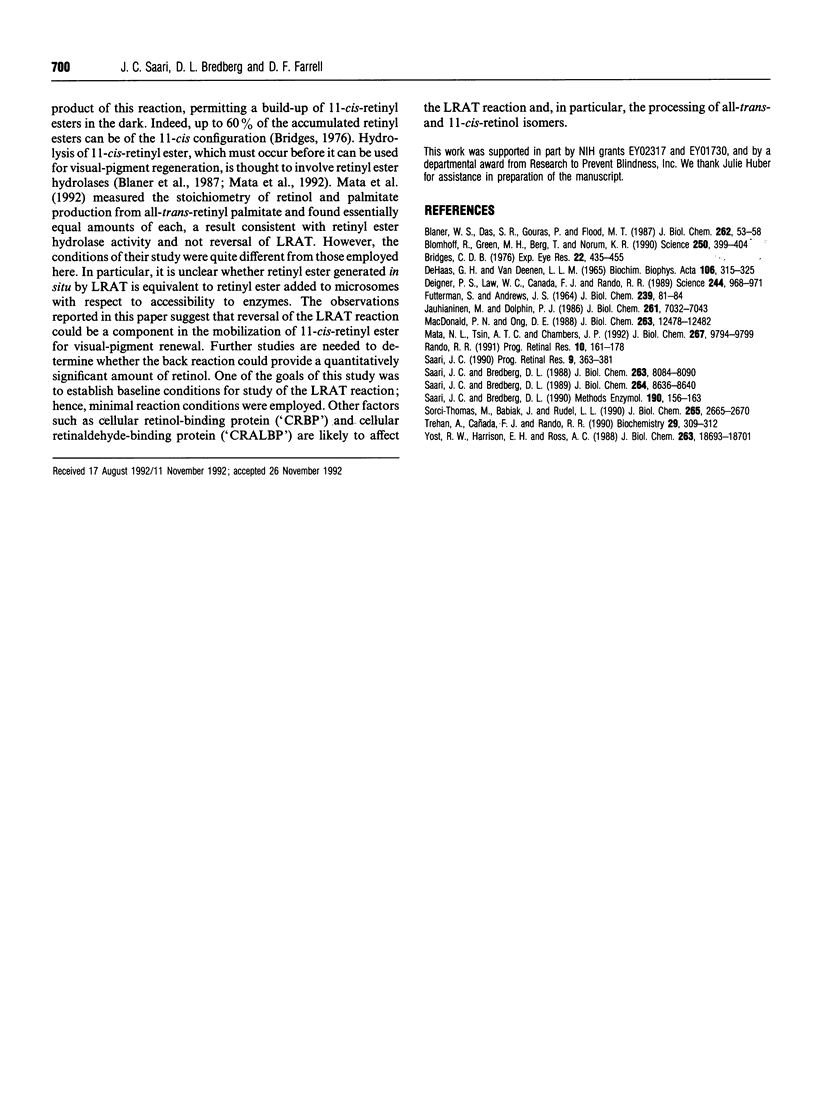Abstract
Esterification of all-trans-retinol is a key reaction of the vertebrate visual cycle, since it produces an insoluble, relatively non-toxic, form of the vitamin for storage and supplies substrate for the isomerization reaction. CoA-dependent and -independent pathways have been described for retinol esterification in retinal pigment epithelium (RPE). The CoA-independent reaction, catalysed by lecithin:retinol acyltransferase (LRAT) was examined in more detail in this study. Addition of retinol to RPE microsomes results in a burst of retinyl ester synthesis, followed by a rapid apparent cessation of the reaction. However, [3H]retinol, added when retinyl ester synthesis has apparently ceased, is rapidly incorporated into retinyl ester without a net increase in the amount of ester. The specific radioactivities of [3H]retinol and [3H]retinyl ester reach the same value. [14C]Palmitate from palmitoyl-CoA is incorporated into preexisting retinyl ester in the absence of net ester synthesis, too. These exchange reactions suggest that the reaction has reached equilibrium at the plateau of the progress curve and that only the accumulation of retinyl ester, and not its synthesis, has stopped during this phase of the reaction. Studies with geometrical isomers of retinol revealed that the rate of exchange of all-trans-retinol with all-trans-retinyl esters was about 6 times more rapid than exchange of 11-cis-retinol with 11-cis-retinyl ester. This is the first demonstration of the reversibility of LRAT and the first example of stereospecificity of retinyl ester synthesis in the visual system. Reversal of the LRAT reaction could contribute to the mobilization of 11-cis-retinol from 11-cis-retinyl ester pools.
Full text
PDF



Images in this article
Selected References
These references are in PubMed. This may not be the complete list of references from this article.
- Blaner W. S., Das S. R., Gouras P., Flood M. T. Hydrolysis of 11-cis- and all-trans-retinyl palmitate by homogenates of human retinal epithelial cells. J Biol Chem. 1987 Jan 5;262(1):53–58. [PubMed] [Google Scholar]
- Blomhoff R., Green M. H., Berg T., Norum K. R. Transport and storage of vitamin A. Science. 1990 Oct 19;250(4979):399–404. doi: 10.1126/science.2218545. [DOI] [PubMed] [Google Scholar]
- Bridges C. D. Vitamin A and the role of the pigment epithelium during bleaching and regeneration of rhodopsin in the frog eye. Exp Eye Res. 1976 May;22(5):435–455. doi: 10.1016/0014-4835(76)90182-2. [DOI] [PubMed] [Google Scholar]
- Deigner P. S., Law W. C., Cañada F. J., Rando R. R. Membranes as the energy source in the endergonic transformation of vitamin A to 11-cis-retinol. Science. 1989 May 26;244(4907):968–971. doi: 10.1126/science.2727688. [DOI] [PubMed] [Google Scholar]
- FUTTERMAN S., ANDREWS J. S. METABOLISM OF THE RETINA. IV. THE COMPOSITION OF VITAMIN A ESTER SYNTHESIZED BY THE RETINA. J Biol Chem. 1964 Jan;239:81–84. [PubMed] [Google Scholar]
- Jauhiainen M., Dolphin P. J. Human plasma lecithin-cholesterol acyltransferase. An elucidation of the catalytic mechanism. J Biol Chem. 1986 May 25;261(15):7032–7043. [PubMed] [Google Scholar]
- MacDonald P. N., Ong D. E. Evidence for a lecithin-retinol acyltransferase activity in the rat small intestine. J Biol Chem. 1988 Sep 5;263(25):12478–12482. [PubMed] [Google Scholar]
- Mata N. L., Tsin A. T., Chambers J. P. Hydrolysis of 11-cis- and all-trans-retinyl palmitate by retinal pigment epithelium microsomes. J Biol Chem. 1992 May 15;267(14):9794–9799. [PubMed] [Google Scholar]
- Saari J. C., Bredberg D. L. Acyl-CoA:retinol acyltransferase and lecithin:retinol acyltransferase activities of bovine retinal pigment epithelial microsomes. Methods Enzymol. 1990;190:156–163. doi: 10.1016/0076-6879(90)90020-2. [DOI] [PubMed] [Google Scholar]
- Saari J. C., Bredberg D. L. CoA- and non-CoA-dependent retinol esterification in retinal pigment epithelium. J Biol Chem. 1988 Jun 15;263(17):8084–8090. [PubMed] [Google Scholar]
- Saari J. C., Bredberg D. L. Lecithin:retinol acyltransferase in retinal pigment epithelial microsomes. J Biol Chem. 1989 May 25;264(15):8636–8640. [PubMed] [Google Scholar]
- Sorci-Thomas M., Babiak J., Rudel L. L. Lecithin-cholesterol acyltransferase (LCAT) catalyzes transacylation of intact cholesteryl esters. Evidence for the partial reversal of the forward LCAT reaction. J Biol Chem. 1990 Feb 15;265(5):2665–2670. [PubMed] [Google Scholar]
- Trehan A., Cañada F. J., Rando R. R. Inhibitors of retinyl ester formation also prevent the biosynthesis of 11-cis-retinol. Biochemistry. 1990 Jan 16;29(2):309–312. doi: 10.1021/bi00454a001. [DOI] [PubMed] [Google Scholar]
- Yost R. W., Harrison E. H., Ross A. C. Esterification by rat liver microsomes of retinol bound to cellular retinol-binding protein. J Biol Chem. 1988 Dec 15;263(35):18693–18701. [PubMed] [Google Scholar]
- de Haas G. H., van Deenen L. L. Structural identification of isomeric lysolecithins. Biochim Biophys Acta. 1965 Oct 4;106(2):315–325. doi: 10.1016/0005-2760(65)90040-8. [DOI] [PubMed] [Google Scholar]



